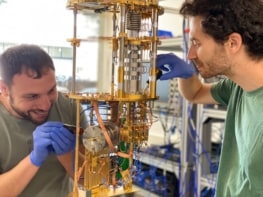
Graphene responds strongly to light at terahertz frequencies and this could be fine-tuned to make practical devices. That is the conclusion of researchers in the US who believe that their findings could help lead to graphene finding use in a wide range of applications that include medical imaging and security screening.
Terahertz radiation lies between the microwave and mid-infrared regions of the electromagnetic spectrum. It passes through clothing and packaging but is strongly absorbed by metals and other inorganic substances, making it of great interest to those developing airport security scanners. However, the radiation has proven extremely difficult to create, manipulate and detect.
Now, Feng Wang and colleagues at the Lawrence Berkeley National Laboratory and the University of California at Berkeley say that they have made the “beginnings of a toolset” for working with terahertz radiation. The technology is based on graphene, which is a sheet of carbon just one atom thick. The graphene is arranged in arrays of extremely narrow ribbons, called nanoribbons. The terahertz response of the array can be tuned by varying the width of the ribbons and the number of charge carriers (electrons and holes) in the structures. In fact, varying these two parameters allows the researchers to control the collective oscillations of electrons (plasmons) in the graphene ribbons, and it is these plasmons that couple strongly to the terahertz light.
Lower-frequency plasmons
Plasmons are more familiar to us in the high-frequency, visible part of the electromagnetic spectrum and notably in 3D metallic nanostructures. One well known example of where they can be seen is in stained glass windows. Here, the colours come about from oscillating collections of electrons on the surfaces of nanoparticles of gold, copper and other metals contained in the glass. However, graphene is only one atom thick and its electrons move in just two dimensions, explains Wang, so plasmons in this material occur at much lower frequencies.
What is more, terahertz radiation lies in the wavelength range of between about 1 to 0.03 mm but the width of the graphene ribbons is just 1–4 µm. “A material that consists of structures with dimensions much smaller than the relevant wavelength, and which exhibits optical properties distinctly different from the bulk material, is called a metamaterial,” said Wang in a LBNL press release. “So we have not only made the first studies of light and plasmon coupling in graphene, we’ve also created a prototype for future graphene-based metamaterials in the terahertz range.”
Resonant excitations
So, how can varying the width of the graphene nanoribbons make them absorb different frequencies of light? As mentioned, a plasmon describes the collective oscillations of many electrons but its frequency depends on how rapidly these oscillations travel between the edges of a ribbon. When light of the same frequency as the oscillations is applied, a “resonant excitation” results, something that produces an increase in the strength of the oscillations and the amount of light absorbed at that frequency. Because the frequency of the oscillations depends on the width of the ribbon, varying its width thus allows it to absorb different frequencies of light.
The number of charge carriers in the ribbon can also affect the strength of the coupling between light and plasmons. One advantage of graphene is that the concentration of charge carriers can easily be increased or decreased in the material by applying a strong electric field. Such a technique is called electrostatic doping. The researchers have also found that light shone perpendicularly onto the ribbons is much better absorbed at the plasmon resonant frequency than light shone at other angles.
Room-temperature measurements
Wang and co-workers obtained their results by shining terahertz light (from the beamline at Berkeley Lab’s Advanced Light Source) onto the graphene ribbon arrays. They then measured the light transmitted using the beamline’s infrared spectrometer. The result shows that coupling between light and plasmons in graphene is an order of magnitude stronger than in other 2D systems, like semiconductors. The light absorption in graphene can also be measured at room temperature unlike in these other materials, which need to be near absolute zero in experiments.
“Wang’s team reports an interesting study of plasmons in graphene ribbons and shows how to tune their properties, and the work represents a further step in understanding light-electrons interactions in this material,” commented Andrea Ferrari of Cambridge University, who was not involved in the work. “The terahertz range covered by these experiments could eventually enable products such as portable terahertz sensors for remote detection of dangerous agents, environmental monitoring or high-speed wireless communications. However, to achieve these goals will require much more effort on the part of the graphene and plasmonics communities.”
Wang told physicsworld.com that his team, for its part, is now looking into designing different metamaterial structures from graphene and examining their properties.
The current work is published in Nature Nanotechnology.



